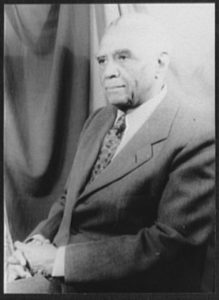
Laurence C. Jones
*Laurence Jones was born on this date in 1882. He was a Black educator, administrator, and activist. From St. Joseph, Missouri, his father worked as a porter at the Pacific House Hotel. Laurence Clifton Jones came from a family of educators with an uncle who founded the Woodstock Manual Labor Institute in Michigan in 1846.
When he was 15, he relocated to Marshalltown to live with an aunt and uncle. 1903, Jones became the first African American to graduate from Marshalltown High School. He recalled how the opportunity to pen his graduation class song was “the first time anyone had confidence in me.”After graduating from the University of Iowa in 1908, Jones turned down an offer to teach at the Tuskegee Institute in Alabama, instead opting to teach at the small Utica Institute, a school for African American children located in Utica, Mississippi.
While there, he was recruited by the congregation of St. John's Baptist Church of D'Lo, Mississippi, to build a school. White residents of the area had initially thwarted the efforts of the church to start a school for their children. When he learned about rural Rankin County, Mississippi, which had an eighty percent illiteracy rate, Jones identified his personal mission. In 1909, Jones agreed to teach a poor youngster to read and soon found himself teaching a small group of students. He started the Piney Woods School with just $2 and three students. A local freed slave named Ed Taylor gave Jones 40 acres and an abandoned sheep shed to start his school.
After marrying Grace Morris Allen in 1912 (She founded the Grace M. Allen Industrial School for Black students in Burlington, Iowa), Jones built a larger school to accommodate many students interested in attending. A local white sawmill owner donated the wood for that building, and dozens of other donations arrived, including cattle for milk, a large amount of land near the school, and cash. Throughout the rest of her life, she was pivotal in helping her husband fundraise for the school by teaching domestic science courses.
In his book How to Stop Worrying and Start Living, white author and motivator Dale Carnegie told how Jones had survived a near-lynching in 1918 by demonstrating to the white mob how passionate he was about his efforts to educate Black children. Several accounts support Carnegie's account that after being persuaded not to lynch him, the crowd collected money to give Jones to support his school. Carnegie said, "No man can force me to stoop low enough to hate him." Jones used the "Booker T. Washington model" of training Blacks to be good workers. He followed the Jim Crow social codes of the South, and his school thrived without controversy and with encouragement from white people throughout Mississippi.
Piney Woods taught agriculture, carpentry, dairy farming, and construction. Under his guidance, students were responsible for building many of the facilities on the campus, starting with a boys' dorm in 1922. In 1929, with the arrival of Martha Louise Morrow Foxx to serve as principal, the Mississippi Blind School for Negroes was founded on the campus; it eventually moved to Jackson, Mississippi. With assistance from his wife, Jones led several singing groups across the South, the Midwest, and the East on fundraising tours. The schools' Five Blind Boys of Mississippi, the Cotton Blossom Singers, and the International Sweethearts of Rhythm were three of several acts.
His daughter Helen Jones Woods was a member of the band. Beginning in the 1930s, the school also sponsored baseball teams as part of the fund-raising efforts. Jones appeared on the This Is Your Life television show in the 1950s and, after telling his story, asked viewers to each send in $1 to support the school. This bid eventually raised $700,000, with which Jones began the school's endowment fund, reportedly at $7,000,000 in 1975.
He received honorary doctorates from Clarke College, Cornell College, University of Dubuque, and Otterbein College. He also earned an honorary Master of Arts from the Tuskegee Institute. He was recognized for his contributions to the education of Black children by the University of Iowa when college president Virgil Hancher named him one of the University's most outstanding alumni in 1954.
Jones also sat on boards for the Mississippi Federation of Colored Women's Clubs and the state executive committee for the Y.M.C.A. He was also the author of several books, including Up Through Difficulties, published in 1910; Piney Woods and Its Story, published in 1923; and The Bottom Rail, published in 1933. Jones spent his adult life supporting the educational advancement of rural Black students in the segregated South. Laurence C. Jones died on July 13, 1975.